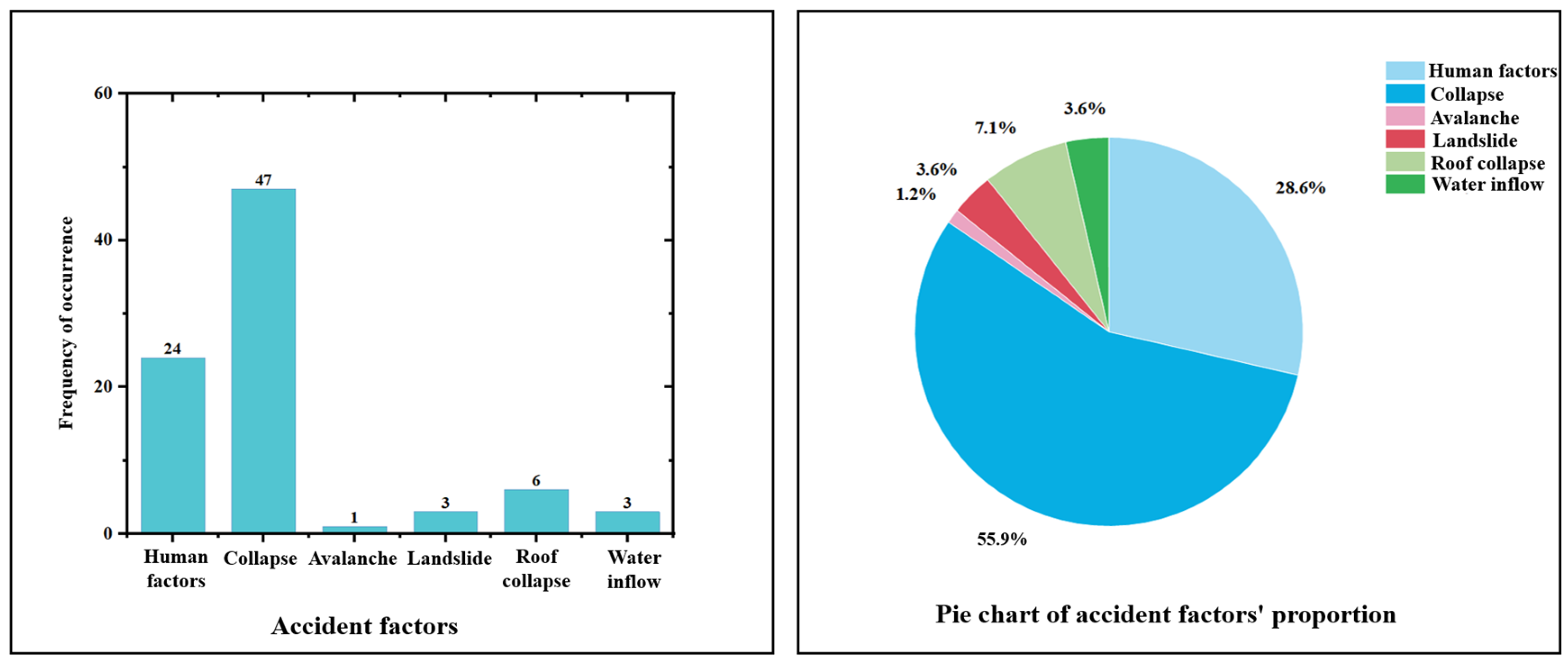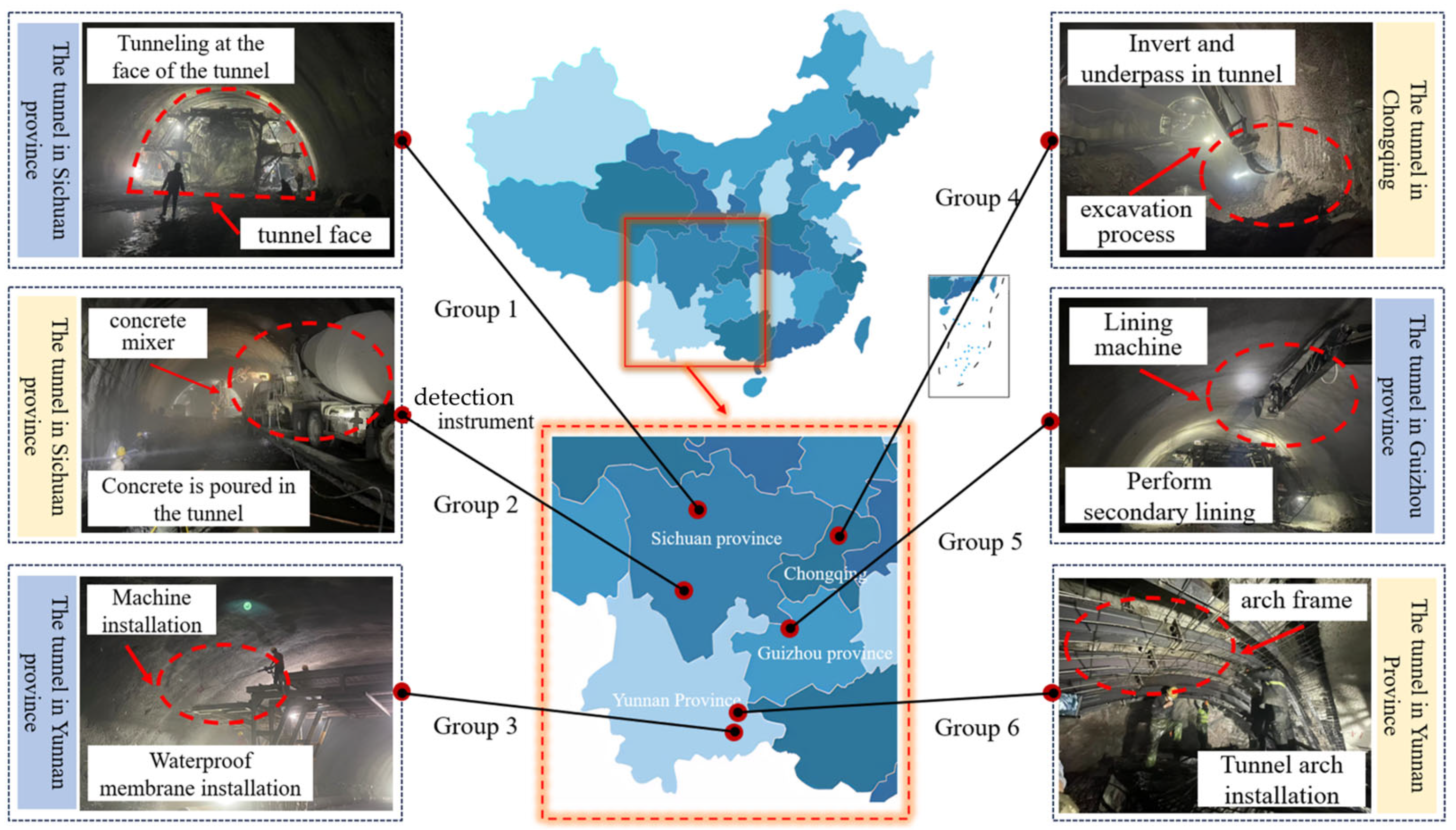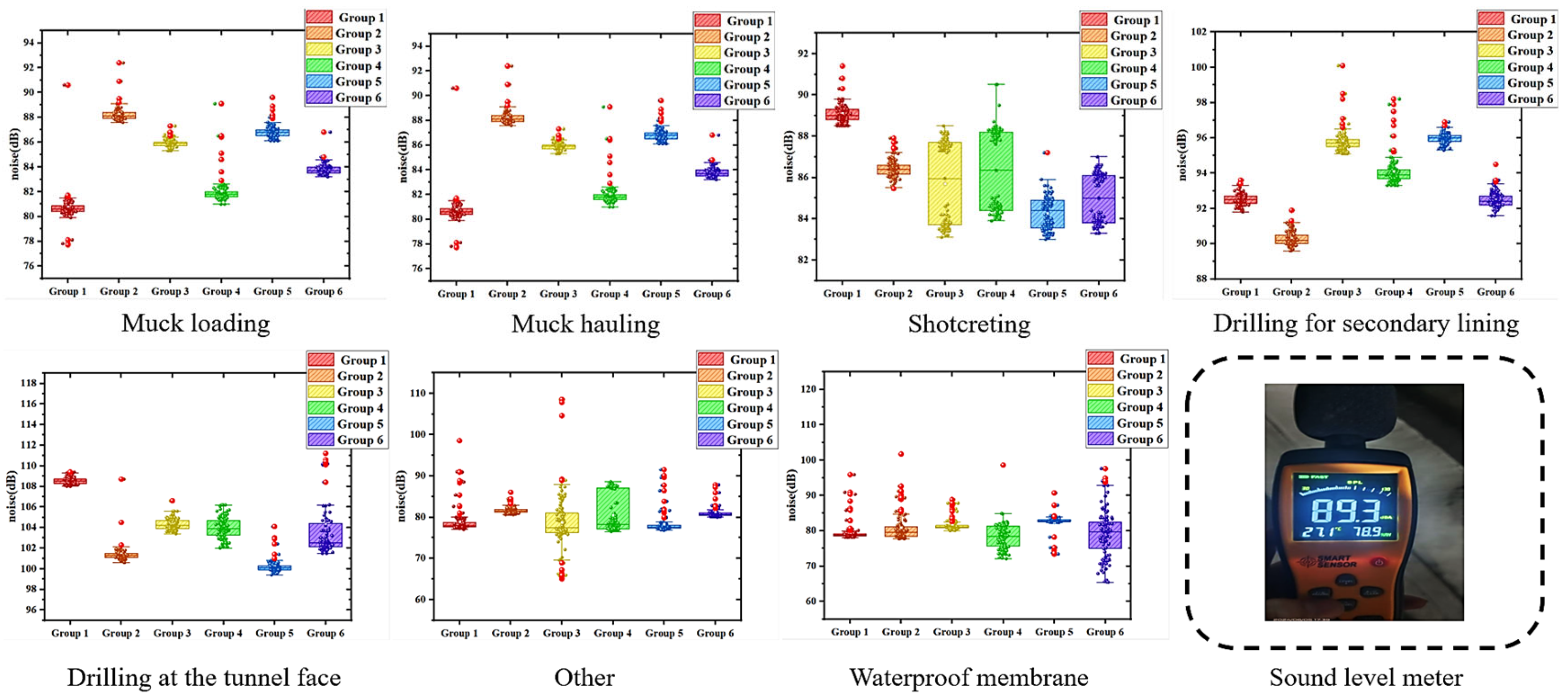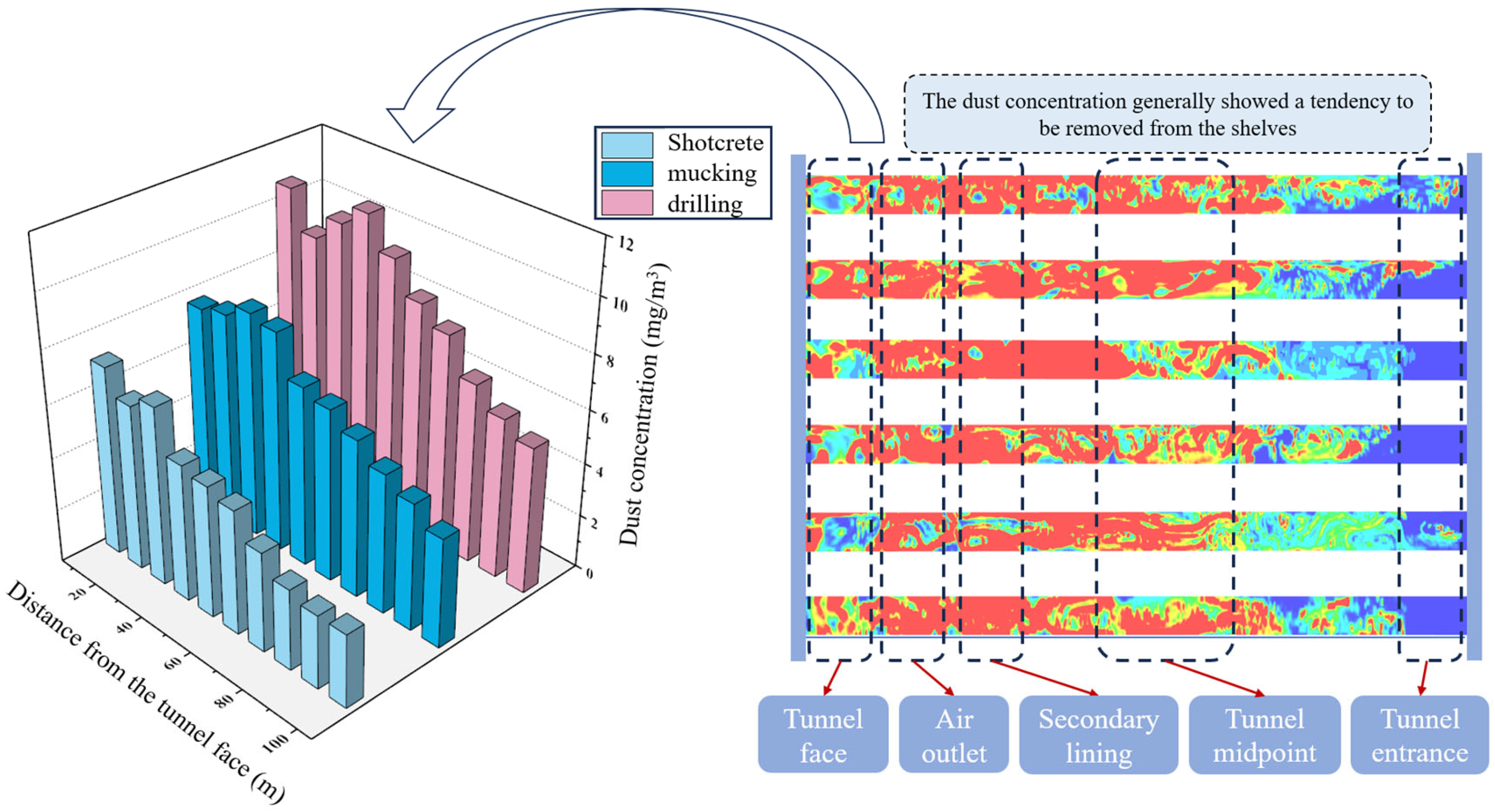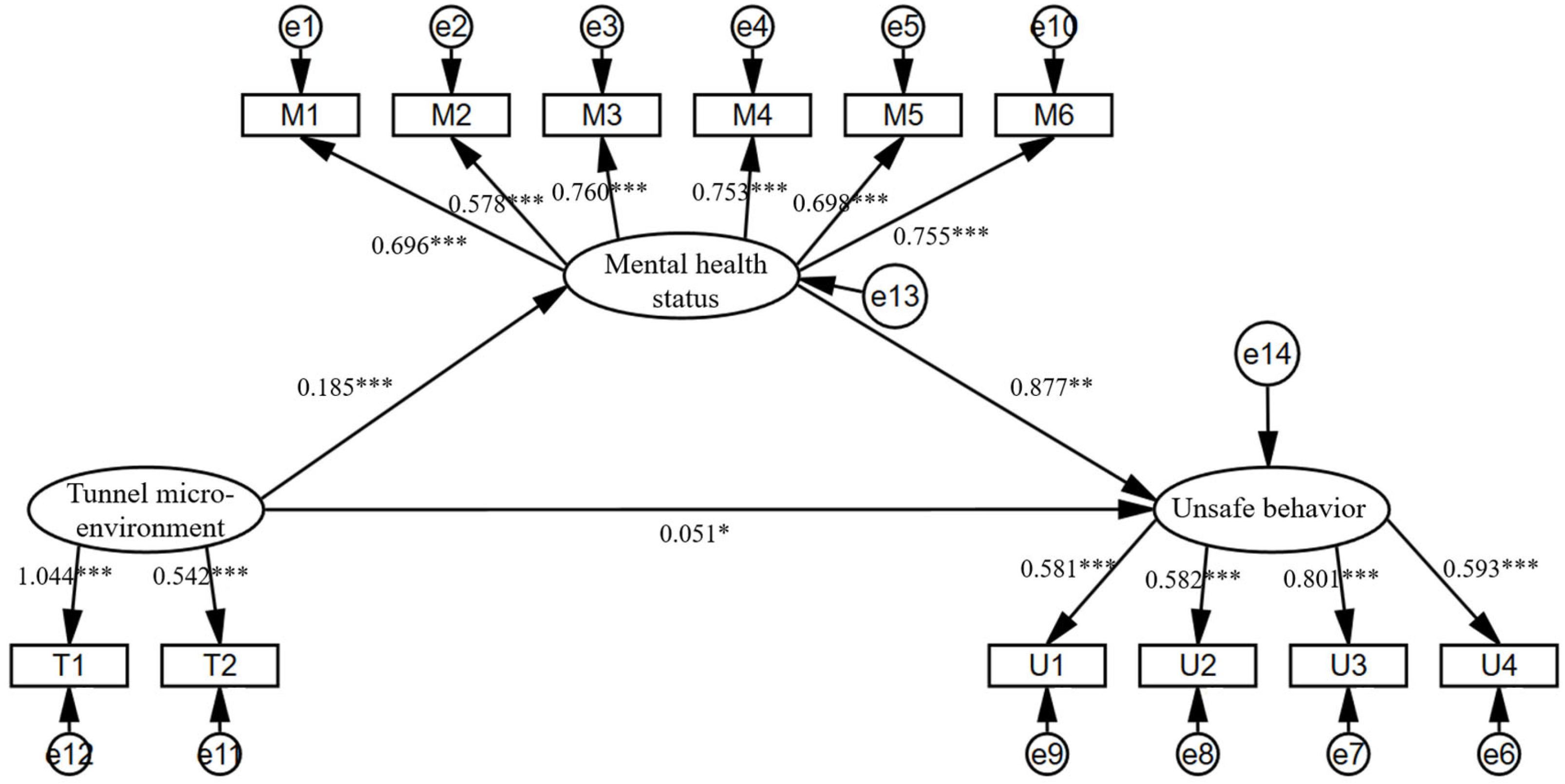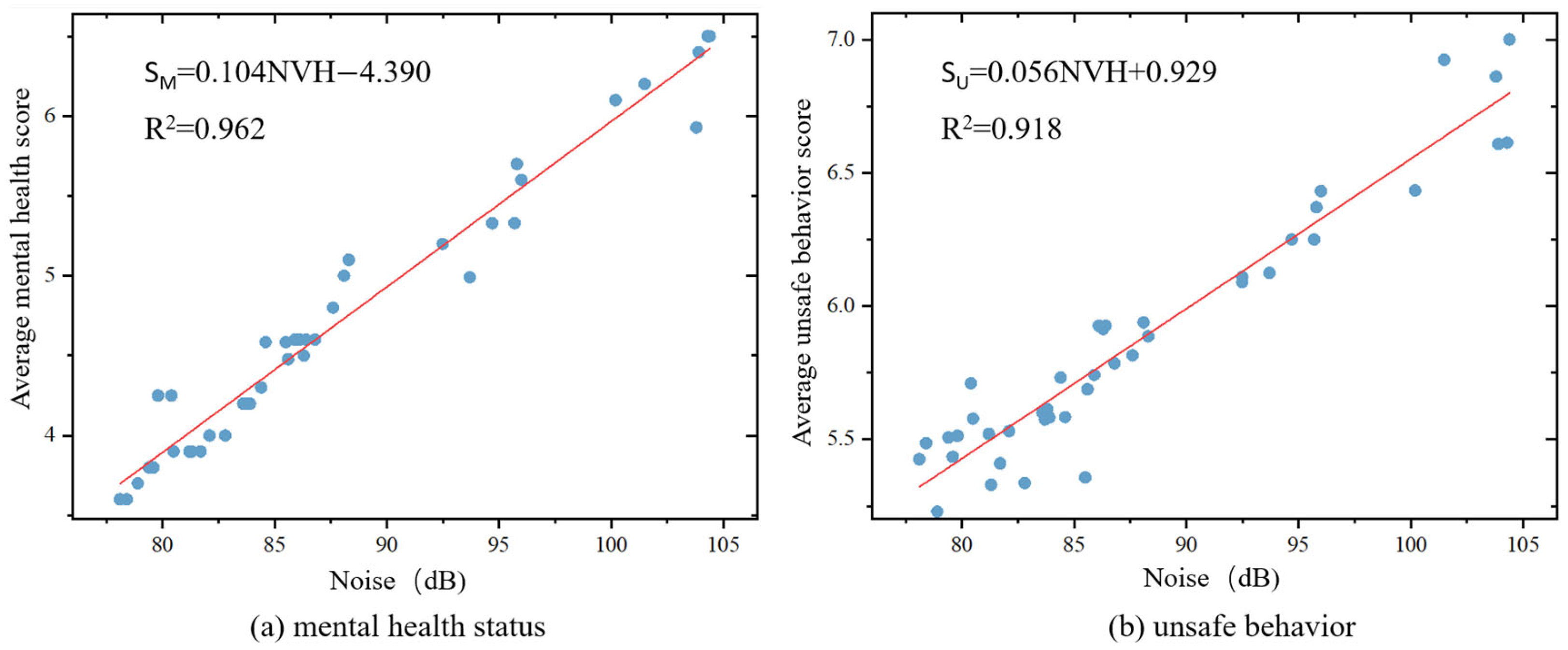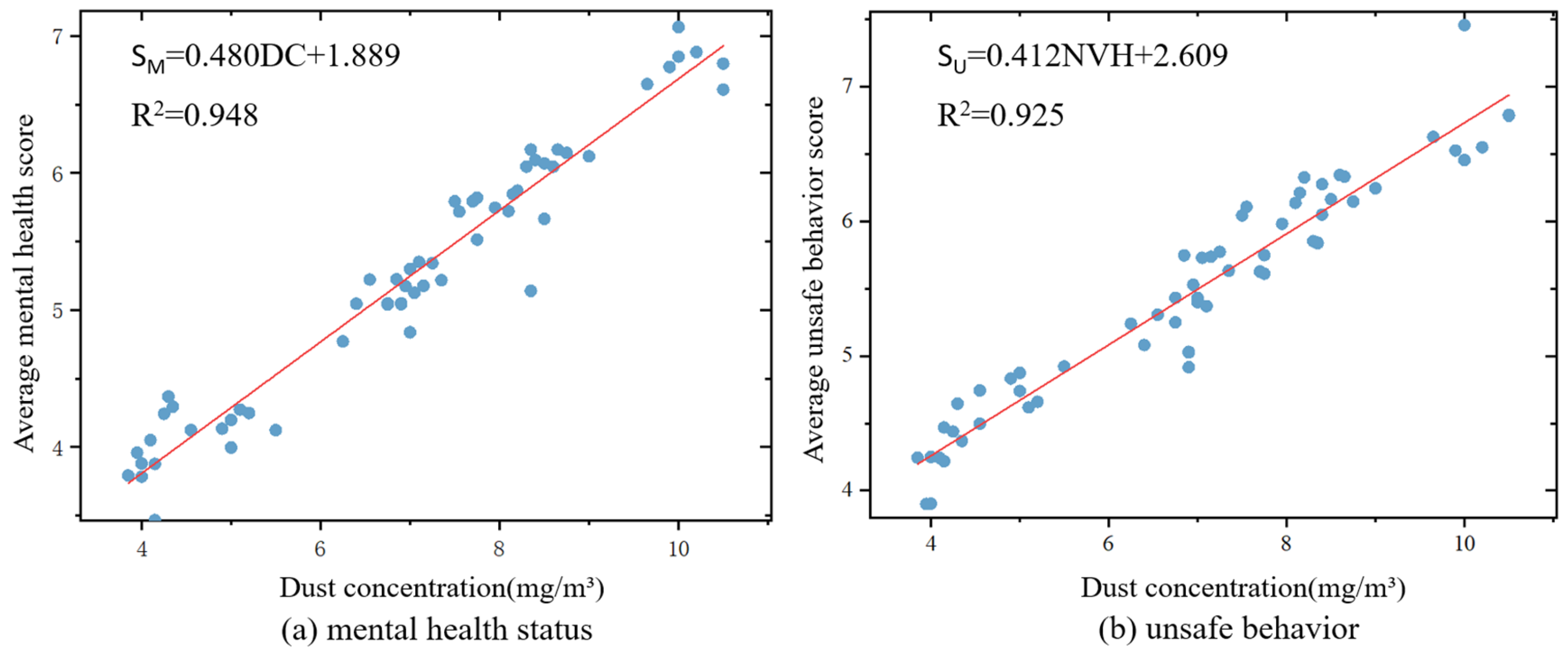3.1. Research Data
The present study is predicated on field research conducted from early 2023 to mid-2024, covering six highway tunnels (Groups 1 to 6) in four cities in China. The tunnels under scrutiny in this study were constructed using the mining method, and their geographical locations and construction characteristics are illustrated in
Figure 3. The study area was selected to encompass tunnels in the southwestern mountainous regions of China, namely Yunnan, Guizhou, Sichuan, and Chongqing. These regions are considered to be representative of the complex mountain tunnels that are characteristic of China. The study area also takes into full consideration the geological and environmental characteristics of the different engineering contexts. The geology of the southwestern mountains is complex and unique, characterized by weak surrounding rocks, high ground stress, and strong unloading effects. In addition, factors such as steep terrain, inconvenient transportation, and variable climate further exacerbate the difficulty of construction organization and technical implementation. Southwestern mountain tunnels were chosen as the subject of the study not only because they are highly representative of geological and construction problems, but also because their construction risks are much higher than those in other regions, and they are “high-risk zones” where tunnel accidents occur frequently. This selection helps to reveal the interaction mechanism between construction risks, environmental impacts, and engineering design in complex mountainous geological conditions, and provides an important reference for optimizing tunnel construction techniques, reducing safety risks, and mitigating ecological impacts. To ensure the breadth and representativeness of the sample data, this study selects workers from different job types and shifts in proportion to the distribution of workers on each project to participate in the survey, covering the diversity of the construction workforce and increasing the universality of the data and applicability of the conclusions. Survey respondents are predominantly frontline workers. Frontline workers are exposed to harsh environments for longer periods of time than management and technical workers, which better reflects the impact of the tunnel micro-environment on unsafe behavior and mental health states. As some workers had limited understanding of the questions and were unable to answer all of them, part of the questionnaire was completed in the form of an interview. A total of 477 questionnaires were distributed to frontline workers and 438 valid questionnaires were collected.
As shown in
Figure 4, this study used data collected from questionnaires distributed to construction workers at the target tunnels. The questionnaire consists of three main sections: the basic demographic characteristics of tunnel construction workers, their mental health status, and their unsafe behavior status. Statistics on basic demographic characteristics include gender, age, marital status, years of work experience, educational level, etc. Additionally, the work characteristics of tunnel construction workers were surveyed, covering six items: daily working hours, monthly rest days, job type, work location, respiratory symptoms, and type of work process.
The second part focuses on the mental health status of tunnel construction workers. To accurately assess the psychological status of tunnel construction workers, this study used a questionnaire tool based on the DASS-21 scale. The DASS-21 scale has been validated many times and has shown high reliability and validity. It has been widely used in clinical and psychological research and has become a classic tool for assessing individual mental health [
44,
45,
46,
47,
48]. We localized and revised the original questionnaire to ensure cultural adaptability and ease of understanding by refining the scale and combining it with expert opinion and the actual working environment and psychological characteristics of tunnel workers. Finally, three measurement dimensions and six measurement items covering mental states such as anxiety, depression, and stress were summarized to comprehensively capture the emotional fluctuations that respondents might experience under extreme working conditions. The six measurement items use a 5-point Likert scale, where the scores “Strongly agree, Agree, Neutral, Disagree, Strongly disagree” are assigned values of “10, 8, 6, 4, 2”, respectively [
49]. The composite level of worker mental health was obtained by calculating the average score of the six questions, and the threshold distribution of mental health score is shown in
Table 1.
The final section aims to assess the unsafe behavior of construction workers and provide data to support tunnel safety research. The questionnaire design refers to Rafiq’s construction worker unsafe behavior questionnaire, which explores various factors influencing unsafe behaviors [
50,
51]. The questionnaire is rooted in behavioral safety theory and accident causation models. It comprises four questions designed to comprehensively assess typical unsafe behaviors in the workplace. These questions encompass the four dimensions of personal protection, operating norms, environmental interaction, and individual condition. The dimensions are both independent and complementary, and work together to build a comprehensive framework for investigating unsafe behavior. The four measurement items use a 5-point Likert scale, where the scores “Strongly agree, Agree, Neutral, Disagree, Strongly disagree” are assigned values of “10, 8, 6, 4, 2”, respectively. By calculating the average score of the four items, the worker’s unsafe behavior score is obtained. The thresholds for unsafe behavior scores are shown in
Table 1.
3.2. Tunnel Construction Micro-Environment Data Collection
Field tests have indicated that key indicators of the tunnel micro-environment include noise and dust concentrations, which have a direct impact on the health and behavioral safety of construction personnel. This study precisely determines the noise and dust exposure of workers in different tasks under various environmental conditions by conducting detailed measurements of noise and dust data across different job types, construction stages, and work areas, and integrating the detailed information on job types, construction stages, and work locations provided in worker surveys.
During tunnel construction, high-intensity noise generated by equipment operation, blasting operations, and material handling has become an environmental risk that cannot be ignored. The measurement of noise levels was conducted through the implementation of on-site real-time monitoring, thereby ensuring the comprehensiveness and accuracy of the resulting data. The regularity of noise distribution was revealed through the conduction of detailed statistics and analysis of noise data from different types of work, construction stages, and work areas on-site.
In the work areas of tunnel construction personnel, noise levels were measured over one hour using the HIMA handheld industrial-grade noise tester AS844+ (see
Figure 5). As demonstrated in
Figure 5, the measured noise fluctuation during the shotcrete operation was significantly higher than that during other work stages. This phenomenon is closely related to the construction characteristics of shotcrete, particularly during high-pressure spraying, where the concrete violently collides and rubs against the tunnel lining surface, generating significant instantaneous noise peaks. The findings indicate that the noise data of the six tunnels in seven typical work areas and processes demonstrate analogous trends, thereby unveiling the shared characteristics of noise distribution under varying construction conditions. This further substantiates the substantial impact of the construction environment on noise levels, as illustrated in
Figure 6. The figure indicates that the majority of the noise levels exceed 85 dB, particularly in the context of tunnel face drilling and other high-noise operations. The noise peak is observed to occur during the tunnel face drilling phase, with Group 5 demonstrating the highest noise level, exceeding 120 dB. During this phase, noise levels are known to increase significantly, a phenomenon that may be attributed to the use of heavy machinery or the intricate nature of the construction environment. With the exception of the waterproof membrane installation and mucking, the noise levels of the other processes are generally high, with almost all exceeding 85 dB.
In the experiments conducted across all groups (Group 1 to Group 6), while certain discrepancies in the specific noise values were observed, the noise distribution trends in the majority of processes demonstrated a high degree of consistency, exhibiting comparable fluctuation patterns as the processes progressed. This phenomenon indicates that, despite the variation in noise levels among the experimental groups, the process itself exerts a predominant influence on the fluctuation pattern of noise generation. During the execution of each process, the noise fluctuations exhibit regular variations associated with the operational steps. However, external factors such as the type of machinery used, the performance condition of the equipment, the progress of construction, and the on-site working environment may also lead to differences in noise discrepancies. For instance, certain groups may have used high-performance or low-noise equipment, while others may have encountered elevated noise levels due to equipment degradation or substandard maintenance practices. Additionally, the construction progress in different groups may impact the accumulation and distribution of noise, with faster construction progress potentially leading to higher dynamic pressure, thereby causing more significant noise fluctuations. Therefore, in addition to the inherent characteristics of the processes themselves, variables such as equipment configuration and construction progress also have a significant impact on the differences in noise levels. Through the categorized analysis of noise intensity across different work areas and job types, the distribution patterns of noise peaks at each construction stage were further clarified. The face of the tunnel, transportation passages, and areas with concentrated machinery show higher noise levels with greater fluctuations, whereas the noise in management and auxiliary work areas is relatively lower.
Dust concentration monitoring is chiefly reliant upon on-site measured data in conjunction with numerical simulation techniques for the purpose of modelling dust distribution, thus facilitating a more accurate evaluation of dust diffusion within the tunnel. The necessity of dust concentration simulation arises from two factors. Firstly, there are limitations to on-site measured data. Secondly, dust diffusion characteristics are complex. When combined with numerical simulation technology, this approach has the capacity to not only supplement the spatial and temporal blind spots of real measurements, but also to explore the intrinsic mechanism of dust diffusion in depth.
The present study observed the dust mass concentration under various working conditions in the tunnel through on-site testing. The definition of dust mass concentration is the mass of suspended dust per unit volume of air. The CCZ-1000 direct-reading dust concentration meter (The equipment is manufactured by Shunxin Instrument, with its production location in Changshu, China) was used in this investigation, encompassing three primary working conditions during tunnel construction: drilling, mucking, and shotcreting. The selection of test points was based on the varying stages of tunnel construction and spatial layout. Specifically, commencing from the tunnel face, measurement points were established along the tunnel cross-sectional central axis at intervals of 10 to 60 m, encompassing five key locations: the tunnel face, the air outlet, the secondary lining, the tunnel midpoint, and the tunnel entrance. The measurement points were arranged along the central axis of the tunnel cross-section and positioned at a height of 1.3 m above the roadbed. This ensured the representativeness and comparability of the data.
In order to verify the reliability and accuracy of the field test results, numerical simulations of dust concentration from the tunnel face to the portal area were conducted. These simulations were based on actual construction conditions, taking into account the spatial layout of the tunnel, airflow distribution, and dust source characteristics under different working conditions. A three-dimensional numerical model was developed using UG 12.0 software, incorporating key parameters such as tunnel cross-sectional diameter, total length, and ventilation duct distribution. Tetrahedral meshing was applied in Workbench, with refined meshing in critical areas such as ventilation duct outlets to enhance simulation accuracy. Following the importation of the model into the Fluent environment, the Realizable turbulence model was used to solve the continuous-phase airflow field. Subsequently, the Discrete Phase Model (DPM) was activated in order to simulate the motion trajectories and concentration distribution of dust particles in the airflow.
The study utilizes a comparative analysis of field measurements and numerical simulations to elucidate the variation patterns of dust concentration in the tunnel. The analysis demonstrates significant consistency in the variation patterns of dust concentration under different operating conditions. This finding indicates that, irrespective of the working conditions, the fluctuation trends and distribution patterns of dust concentration exhibit similar patterns. However, it is important to note that, despite the consistency in the variation patterns of dust concentration under different operating conditions, the differences between the actual measurement results and the simulation predictions may stem from variations in dust control measures and dust control facilities. Different construction groups may have used different types of dust control equipment or systems, resulting in varying dust concentration control effectiveness under the same operating conditions. For example, some areas may be equipped with efficient local dust control devices or automated spraying systems, which can effectively reduce dust concentration, while other areas may rely on traditional manual cleaning or inefficient dust control measures. These differences can lead to significant variations in dust concentration. Furthermore, the configuration and functionality of the ventilation system are pivotal in determining the distribution of dust concentration. Adequate ventilation conditions facilitate expeditious dust dissipation, while inadequate ventilation may result in dust accumulation within the tunnel.
As demonstrated in
Figure 7, the dust concentration levels during the spraying operation are typically low with minimal variability. Conversely, during mucking, the dust concentration levels are moderate with considerable fluctuations. This suggests that the method of operation and distance are significant factors in determining dust concentration. A further notable observation is that during drilling, dust concentration levels are significantly higher, exhibiting clear fluctuations with distance. This finding indicates that dust emission during the drilling process is substantial. The longitudinal cross-section diagram of the tunnel under the drilling condition shows the distribution of dust mass concentration. The research results show that the dust mass concentration in the tunnel decreases as it extends outward from the face, but in certain areas, the dust concentration exhibits a local pattern of increasing followed by a decrease. This trend is observed within the range from the tunnel face to the secondary lining area, which belongs to the vortex zone. In the region extending from the secondary lining area to the tunnel entrance, the airflow within the tunnel enters the recirculation zone, where the wind speed gradually stabilizes. As the distance increases, the overall wind speed exhibits a decreasing trend. The dilution and dispersion of dust in this area occurs progressively.
This study uses the same numerical simulation method to create a unified model for the same tunnel under different working conditions. Observations indicate that the dust concentration distribution in other working conditions (such as mucking and shotcreting) is generally consistent with that in the drilling condition. In order to streamline the expression, the dust concentration distribution diagrams for each working condition is not shown separately in this paper. The simulation results demonstrate that the spatial distribution of dust concentration is predominantly influenced by the airflow structure, wind speed variations, and construction activities within the tunnel, under different working conditions. Despite the variability in the degree of airflow disturbance across various construction stages, the dust concentration distribution characteristics remain consistent under all working conditions. This consistency can be attributed to the analogous driving mechanisms of airflow and dust dynamics.
3.3. Survey Implementation and Descriptive Statistics
A total of 477 questionnaires were distributed across six representative tunnels under construction. In order to ensure the scientific validity and reliability of the data, strict data cleaning and quality control measures were implemented. Initially, questionnaires with a high number of missing values or anomalies in responses were excluded. Case anomalies were then detected and eliminated using SPSS 27.0 software to ensure the highest possible accuracy of the data. Following the cleansing of the data, 438 questionnaires were found to be valid, with an effective response rate of 91.8%. The geographical distribution of the survey participants and the diversity of the construction environments further enhance the broad applicability of the study.
To examine the impact of tunnel construction micro-environment levels on workers’ unsafe behaviors, the study incorporates individual attribute variables into the control analysis with a view to reducing potential confounding factors. The individual attribute data are derived from the questionnaire survey, covering demographic variables such as gender, age, and years of work experience (see
Table 2). The statistical results show that the sample distribution aligns with the characteristics of construction industry workers, with variables such as gender, education level, and age presenting a reasonable and representative distribution. In terms of gender distribution, the tunnel construction industry is predominantly male, with males accounting for 95.2% and females making up only 4.8%. In terms of marital status, 70.8% of the individuals are married, while 29.2% are unmarried. With regard to age distribution, the workforce involved in tunnel construction is primarily composed of individuals between the ages of 25 and 45, constituting 52.7% of the total, followed by those between 46 and 55, who account for 32%. With regard to educational attainment, it is evident that a significant proportion of construction workers (56.6%) have attained a level of education that is equivalent to junior high school or below. This finding suggests that the overall educational attainment of workers in this industry is comparatively low. In terms of working hours, 43.2% of the workers work 8 to 12 h per day, while 7.7% work more than 12 h. Workers have limited rest time, with 70.3% taking one to three days off per month. In the procedure type statistics, blasting and drilling in tunnel excavation account for 33.7% of the total workforce, the largest proportion, followed by secondary lining, arch crown, and steel frame/rebar mesh binding. These procedures are all carried out in relatively harsh working environments. In the workplace statistics, the largest number of workers are found at the tunnel face and the secondary lining area, accounting for 47.7% and 31.0%, respectively. This indicates that most tunnel workers work deep within the tunnel. With regard to health status, 10.7% of construction workers report suffering from respiratory diseases, while 89.3% do not have such conditions. Furthermore, the report indicates that 31.1% of the workers exhibit medium-risk mental health issues, while 51.8% manifest high-risk mental health issues, signifying a substantial psychological burden on tunnel construction workers. Finally, with regard to unsafe behavior, 45.9% of the workers exhibited medium-risk unsafe behaviors, while 66.7% engaged in high-risk unsafe behaviors, indicating a high frequency of unsafe behaviors among tunnel construction workers. During the course of the investigation, no instances of very high-risk mental health conditions or unsafe behaviors were observed. During the survey, no instances of extremely high-risk mental health states or unsafe behaviors were observed. This phenomenon can be attributed to the fact that when workers experience extreme mental health issues or exhibit significant unsafe behaviors, they typically become unable to continue performing normal work.
